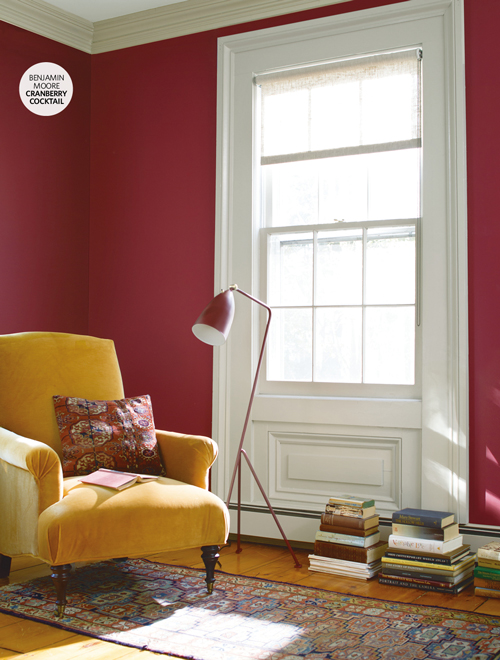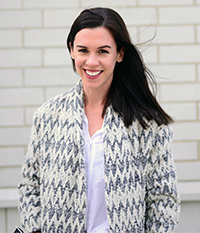Here’s everything you need to know about the colorful stuff, otherwise known as one of the most transformative elements of your home — from how to pick the best color for every room in your house, to how to choose the safest, most eco-friendly paint for your family.
Shade Selection

Settling on a single hue is no easy task, especially once you realize that all 50 (million) shades of gray aren’t exactly created equal. Read on for an expert-led journey to color nirvana — in three easy steps.
1. Get Inspired
“Start by taking note of the things you’re drawn to — anything from a favorite fabric or piece of art to the color of your kitchen countertops,” says Andrea Magno, a color and design expert for Benjamin Moore. “Even a page torn out of a magazine or a picture found online can be a great source of inspiration.” The easiest way to do this: Start a folder or Pinterest board, and keep filling it with things you love. Over time, you’ll find that a color (or palette) will begin to stand out.
2. Pick a Family
Once you find yourself gravitating toward something specific, head to the paint store for a fan deck. “This will give you a much better idea of the options available,” says Magno. “You’ll see a wide range of colors within each family, and some will be more appealing to you than others.” Jot those down, then log on to Pinterest. “Seeing how the colors you chose look in a wide range of rooms will help you narrow them down,” says Tessa Bediz, an interior designer and co-founder of Two Inspire Design in Evanston.
3. Sample Your Favorites
While your first instinct might be to splash a brushful of each color on the wall you’re painting, try to resist the urge. Instead, designer and 2017 Make It Better “Best Interior Decorator” Ilene Chase of Ilene Chase Design suggests painting your samples onto white poster board. Not only is it less messy than applying it directly onto your drywall, but it’s more accurate since the poster board is bare and your wall may not be, she says. Another bonus: You can hold the paper samples up to other elements in the room, like furniture, rugs and fabric, to see how the different tones complement one another. Once you’ve created a few sample boards, live with them for a bit before you decide. “It’s important to see what they look like at different times of day as the light changes,” says Sue Wadden, director of color marketing for Sherwin-Williams. Once you meet your match, you’ll know — and in the slim chance that you regret your decision, remember that at the end of the day, it’s just paint. “That’s the beauty of it,” says Bediz.
Fall Forecast

This season’s theme: Go big or go home. Here, three chic ways to do just that.
Bold
“Consider painting built-in bookcases a dark color rather than traditional white,” says Amy Bird, interior designer and co-founder of Two Inspired Design. “Black, deep gray and rich green are super trendy right now.”
Bolder
“Make a small space pop by painting the whole thing a dark, moody color,” says Bediz. “Powder rooms and offices look incredible in rich jewel tones such as emerald green or plum.”
Boldest
“Elevate a dining room by papering the walls with something gorgeous and painting the ceiling in a light-colored lacquer,” says Bediz. “The high sheen is incredibly sophisticated and makes a huge impact.”
Pro Tip
“If you’ve fallen in love with a paint chip but don’t like the way it looks on the wall, don’t give up,” says Bediz. “Instead, ask your painter to test a 50 percent tint of the shade. It might make all the di fference, especially if the room doesn’t get a ton of light.”
Scandinavian Redux

You’re probably already hip to the Scandinavian color trend that took the design world by storm a few years ago: a sleek, minimalist palette of bright whites and soft grays. And while the look isn’t going anywhere anytime soon, it is getting cozier — just in time for fall. “We’re starting to see a fusion between those whites and grays with warmer neutrals like sandy beige and blush pink,” says Wadden.
Tricks of the Trade
Designers know a thing or two about creating optical illusions with paint — and now, so will you.
Go With the Flow
“Open concept homes and accent walls don’t mix,” says Bediz. “To maintain that airy, spacious feeling, keep color consistent.”
Lighten Up
Lacking square footage? “Encourage a small home to feel as spacious as possibly by sticking to a light, neutral palette,” says Chase.
Raise the Roof
To make a low ceiling appear higher, “paint the lower half of the room a darker color than the top half,” says Bediz. “Even if it’s just a few shades, it’s a chic look that really makes a difference.”
Pick Your Paint
White Magic
There are hundreds of iterations of the color, from barely-there blues to creamy buttermilks — which explains why choosing just one can be such a headache. Home in on a true neutral with this designer-vetted list.

Flying Colors
Benjamin Moore’s five best-selling shades are winning popularity contests for a reason: They’re that good.

Future Perfect
Looking for the next big thing in color? The shade psychics at Sherwin Williams and Benjamin Moore predict that these hues are about to hit the big time.

Eco-Friendly Paint
By Avery Hansen
Old-Fashioned Milk Paint Company
Since 1974, the Old-Fashioned Milk Paint Company has been mixing up organic paint using real and natural ingredients, including milk protein and minerals. The ingredients found in the base paint are even used in the food and pharmaceutical industries and are all completely biodegradable. The milk paint formula comes in 20 different colors. Cost: $49.95 per gallon
Behr Premium Plus
With more than 4,000 paints exclusively at Home Depot, Behr has created a Premium Plus collection. This collection of paints contains zero-VOC versions of flat, flat enamel, eggshell enamel, satin enamel and semi-gloss enamel. Cost: $23.98 to $28.96 per gallon
Colorhouse Paint
Founded in 2005 by two artists, this Portland-based company is one of the only Green Wise Certified paint companies. When the two owners became concerned with the chemicals in paint, they decided to team-up with paint chemists and green chemists to build a paint formula that had the equal performance quality as their original paint but without all the toxic chemicals that came with it. Their inspired base paints are available in three sheens: flat, eggshell and semi-gloss. Cost: $45.00 per gallon
Benjamin Moore Nature/Aura
Although Benjamin Moore is the oldest paint company on the list, mixing paint since 1883, it continues to keep up modern innovations. One such innovation the company has added is their “green” paint: Aura, a low premium paint, and Natura, a zero-VOC qualifying product. Benjamin Moore gives a green promise on all their environmentally-friendly products. Cost: $56.99 (Natura), $69.99 (Aura)

Kaitlin Madden is a Chicago-based freelance lifestyle writer. Her work has appeared in publications like Martha Stewart Living, Refinery 29, Chicago Magazine, CS Interiors, Freshome, CNN, Architectural Digest and Forbes Travel Guide. She lives in Wicker Park with her husband, toddler son and black lab.
Kaitlin is passionate about supporting the American Red Cross because they do so much good on such a large scale for so many people. She also supports (and encourages everyone to join) Be the Match, a bone marrow and plasma registry that matches the chronically and terminally ill with potential donors from around the country. It’s free to join and submit a cheek swab.

